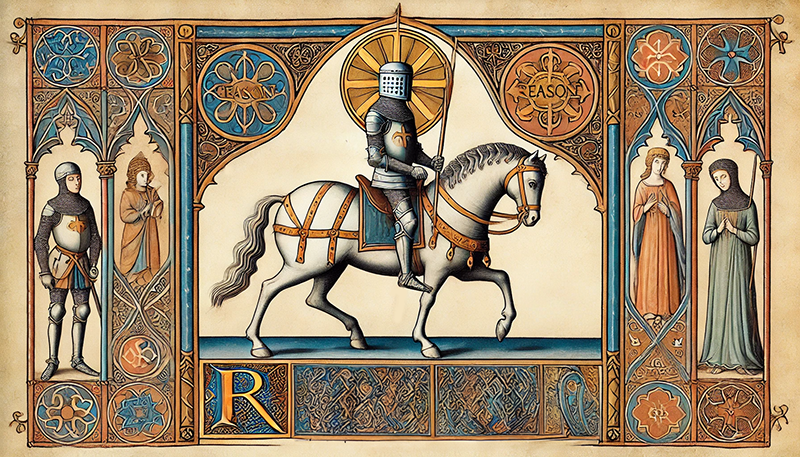The Book of the Order of Chivalry (c. 1275), was written by Ramon Llull (1232–1315), a polymath and Christian mystic from Majorca. Llull thought that knights should be chosen, trained, and ordained like priests. Llull’s book became a handbook of chivalry throughout much of Europe. Being a Christian mystic, of course he writes about Chivalry using Christian vocabulary. But I think his ideas transcend any particular Spiritual Tradition.
Llull wrote over 250 books on a wide range of subjects, including theology, philosophy, logic, science, and even poetry. (And one on Chivalry!) He is best known for his book Ars Magna — a groundbreaking philosophical and logical system that aimed to uncover universal truths using mathematics — now considered the invention of Mathematical Combinatorics. He was also known for his interest in memory and logical systems more generally: his method of linking virtues to physical objects is an example of the ancient memory technique known as the Memory Palace.
An overview of the Order of Chivalry, and a linked table of contents to all my blogs (with music) on various chapters of Llull’s book can be found HERE.

Here Llull equates the horse’s shaffron (armor protecting the horse’s head) with ‘reason’:
The shaffron is given to the horse to signify that a knight must not use arms without reason. For just as the horse’s head goes in front of the knight, likewise reason ought to go before all that a knight does. For all works without reason are vices to him. And as the shaffron protects the horse’s head, likewise reason keeps and defends a knight from blame and shame.
Here Llull equates the horse’s shaffron—armor that protects the horse’s head—with the guiding power of reason in a knight’s life. Just as the shaffron shields the horse’s head from harm, reason serves as a protective force for the knight, ensuring that his actions are guided by wisdom and clarity. Llull’s metaphor emphasizes that reason must precede and govern all actions, for without it, the knight risks falling into vice and dishonor.
“The shaffron is given to the horse to signify that a knight must not use arms without reason.”
The shaffron, positioned at the front of the horse, symbolizes that reason must lead the knight’s every action, particularly when engaging in combat or using arms. Llull stresses that a knight should never act impulsively or without thoughtful consideration. Just as a knight wouldn’t charge into battle without the proper protection for his horse, he should not make decisions without reason guiding him. In many traditions, reason is seen as the primary virtue that governs all other actions. In Aristotle’s philosophy, reason (logos) is what separates humans from animals and is the foundation of ethical behavior, guiding decisions in accordance with virtue and moral responsibility.
“Reason ought to go before all that a knight does.”
Llull underscores the importance of reason as the knight’s first and most essential guide. Reason, like the horse’s head leading the knight, ensures that actions are measured, just, and appropriate. Without reason, even noble intentions can lead to destructive outcomes. This principle resonates with many spiritual teachings that emphasize the importance of mindfulness and reflection. In Buddhism, for example, right intention and right action are grounded in awareness and reason, ensuring that one’s actions are aligned with compassion and wisdom rather than impulsive reactions.
“All works without reason are vices to him.”
Llull makes it clear that when a knight acts without reason, those actions are no longer virtuous but become vices. Without the guidance of reason, even brave or strong actions can devolve into recklessness or cruelty. Reason acts as the compass that ensures that the knight’s strength is channeled toward good and not toward self-serving or destructive purposes. This idea is echoed in many traditions. In Stoicism, for example, reason is the key to maintaining virtue; without it, passions and impulses lead to chaos and suffering. Reason helps to maintain the knight’s moral clarity, ensuring that his actions serve a higher purpose.
“As the shaffron protects the horse’s head, likewise reason keeps and defends a knight from blame and shame.”
The protective nature of the shaffron mirrors the way that reason shields the knight from moral downfall. By allowing reason to guide his decisions, the knight is safeguarded from shame, blame, and dishonor. Just as the shaffron prevents the horse from being injured in battle, reason prevents the knight from making decisions that would lead to disgrace. This metaphor reflects the broader spiritual and philosophical understanding that reason is not only a guiding force but also a form of protection. In Confucianism, for example, reason and wisdom are seen as safeguards against moral corruption, helping individuals maintain their honor and fulfill their societal roles with integrity.
In conclusion, Llull’s metaphor of the horse’s shaffron as reason highlights the central role of rational thought and reflection in the life of a knight. Just as the shaffron protects the horse’s head and leads it in battle, reason must lead the knight’s actions, ensuring that they are virtuous, just, and in service of a higher purpose. Across spiritual and philosophical traditions, reason is revered as the guiding principle that allows individuals to act with wisdom and moral clarity. Llull’s vision reminds us that, without reason, even the most powerful or courageous actions can become harmful, and it is through the disciplined application of reason that one maintains honor, dignity, and integrity.



Leave a Reply